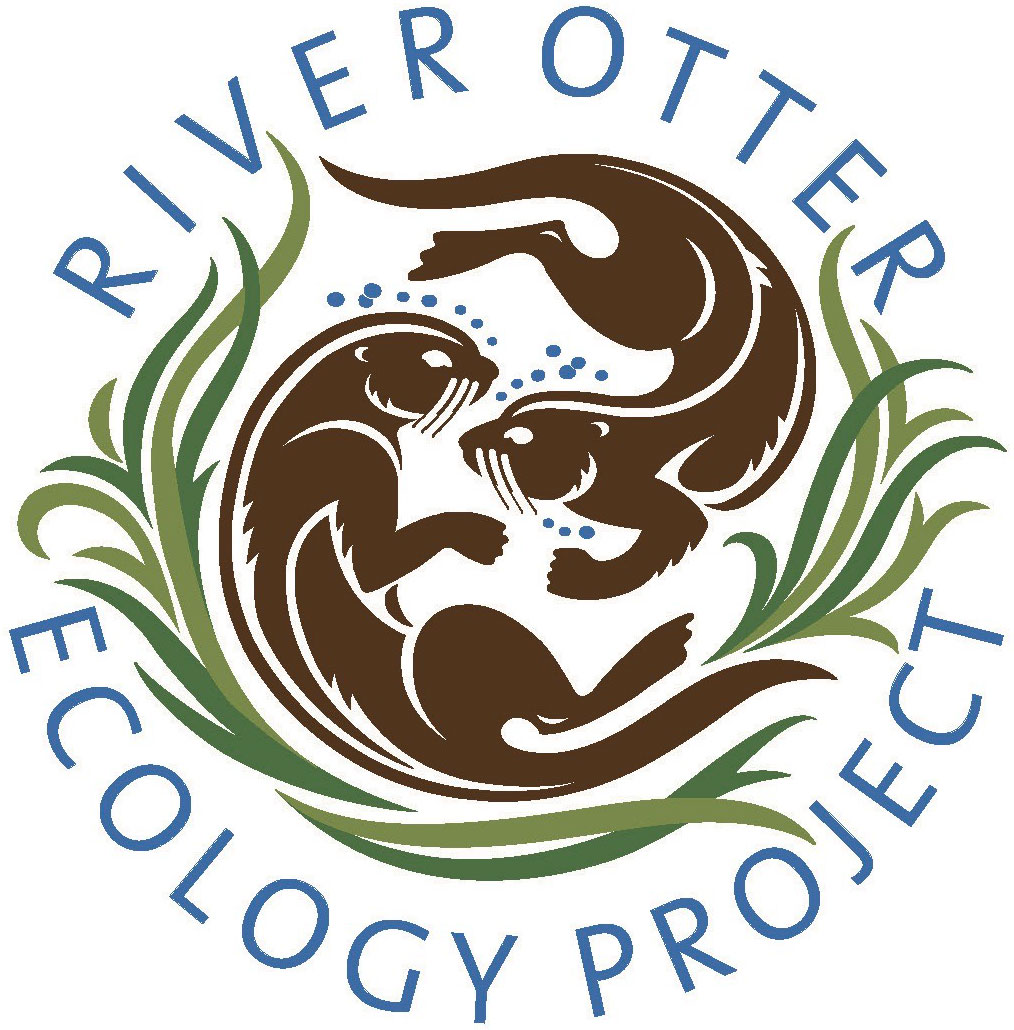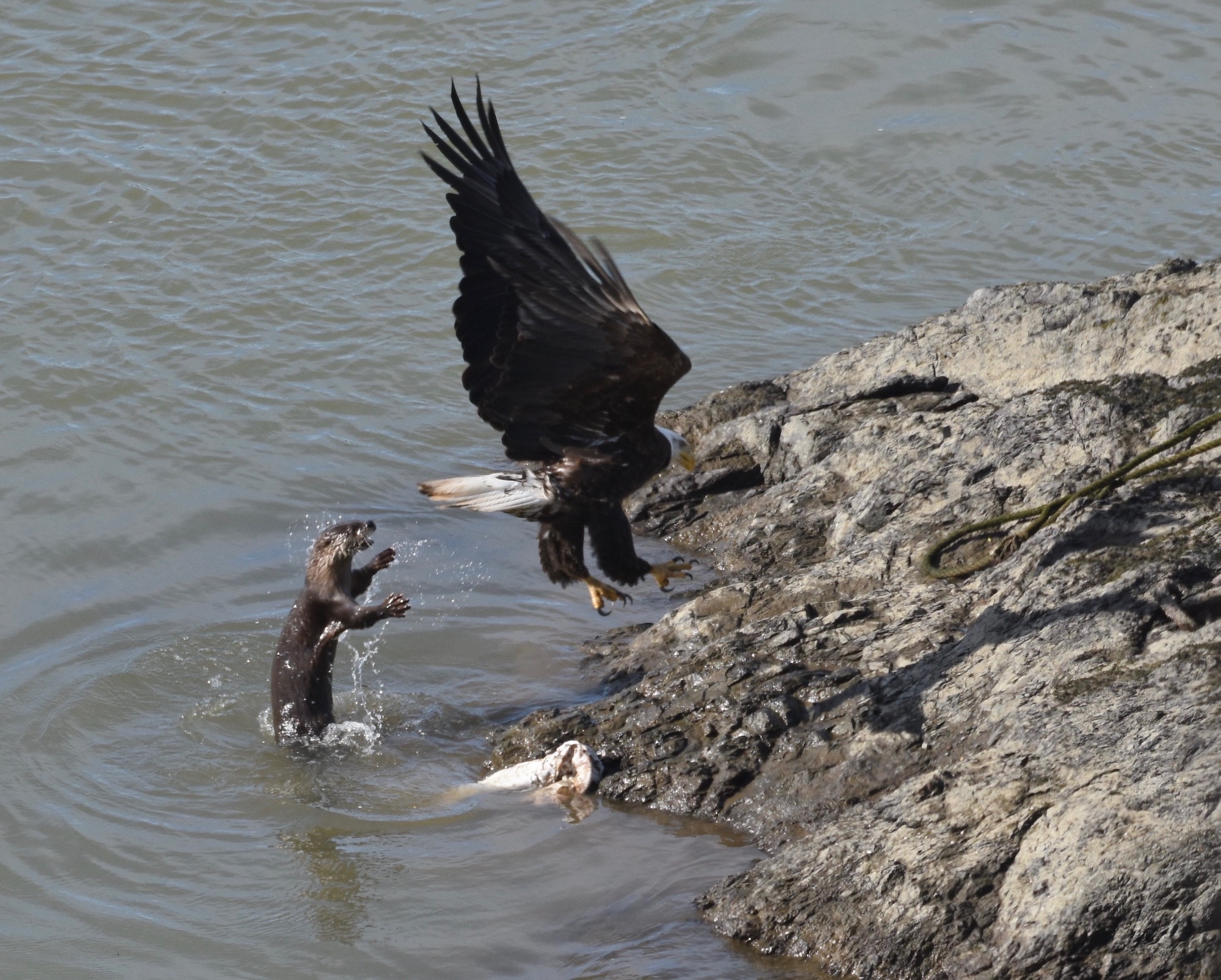By Andrea A. Treece
Andrea is a field volunteer with River Otter Ecology Project’s monitoring program in Marin County. She spends her workdays as a senior attorney for for EarthJustice, protecting forage fish species like herring, anchovies and sardines, which serve as the building blocks of the ocean food web and are being overfished at unsustainable levels.
When I embarked on my first otter-spotting adventure, I had no idea that river otters would open up a new perspective on the place we call home and the creatures we share it with. As I walked to Abbott’s Lagoon with River Otter Ecology Project Executive Director Megan Isadore, I was prepared to be satisfied just to see evidence of them: a latrine site full of scat, some paw prints in the mud, streaks in the dune where pups had used it as a slide. Then one appeared, gliding like quicksilver through the water, diving abruptly and coming up already munching the fish it had caught. When Megan explained that otters also take birds, pointing to the remains of a cormorant, I was stunned. She recounted a recent sighting of an otter chasing a coyote away from its hard-won meal. I knew there was more to river otters than their buoyant adorableness. But I didn’t know just how resilient they are, or how omnipresent they are in their environment.
Nearly extirpated from the San Francisco Bay Area and points south by trapping, pollution, and habitat destruction, these charismatic explorers have made their way back to many streams, lakes, and lagoons in Marin County. Part of their success owes to habitat restoration projects that were intended to benefit other species, particularly native salmon species brought to the brink by damming and pollution. It’s hard to know how much these habitat restoration efforts may have inadvertently contributed the return of river otters, but the relationship between salmon restoration efforts and river otters merits further investigation. Salmon and river otters are both sentinels of stream health. While salmon provide a measure of ideal conditions for a specific (and highly important) set of species, river otters provide a measure of how well the ecosystem is doing at a broader scale. Is the water clean enough for most species? Are prey species abundant and varied? As climate change and biodiversity loss threaten to weaken stream ecosystems, otters may offer both useful knowledge and even a helping paw promoting ecological balance.
Lagunitas Creek has been the focus of ongoing restoration efforts since the 1980s. The 103-square mile Lagunitas Creek watershed stretches from its source on the northern slope of Mount Tamalpais to Tomales Bay, including San Geronimo Creek, Devils Gulch, Nicasio Creek, and Olema Creek. Historically this watershed hosted huge runs of native salmon. Lagunitas Creek still hosts the largest run of endangered wild coho in Central California and provides essential habitat for much of local steelhead population. But those runs are a small fraction of the multitudes seen before Lagunitas Creek—and nearly all of the creeks except San Geronimo—were dammed in the late 1800s to mid-1900s to create reservoirs (Kent, Alpine, Bon Tempe, Lagunitas, and Nicasio). Salmon require cold, clean, fast-moving streams for spawning, as well as deep pools and side channels to rest, hide from predators, and grow after hatching. Damming, development, and runoff left Lagunitas Creek warmer, murkier, lazier, and devoid of deep pools and pockets of woody debris.
Efforts to restore Lagunitas Creek to a more natural, salmon-friendly place began in the 1980s and 90s and continue to this day. Much of the restoration involves placing logs and other large woody debris in the creek to create side channels, deep pools, and riffles—all the spots that salmon need for spawning, hatching, rearing, and hiding from predators.
Enter the river otter—a highly efficient predator with a flexible diet, a never-back-down attitude, and the wherewithal to reestablish itself in far-flung places. When the Lagunitas Creek restoration projects started, river otters did not officially exist in Marin County. As recently as 1995, the California Department of Fish and Wildlife listed the critters as “non-occurring” in the region. But while wildlife agencies focused their attention on imperiled fish, the otters spread back into their former romping grounds. Thanks to nearly a decade of ROEP’s research and community science efforts, river otters are officially back on most parts of the Lagunitas Creek watershed map.
Otter chases off two coyotes! ROEP camera trap video
River otters provide a marvelous lens through which to examine restoration effects for several reasons. First, they are apex aquatic predators that hunt everything from bugs to fish to small mammals and even birds. By keeping populations of their favorite prey in check, they can change the relative abundance of some species at the expense of others—they can balance or tip the ecological scales. They may even help salmon survival. While otters do eat adult salmon, they prefer slower moving fish, including non-native species like carp and generally don’t prey on young salmon. In fact, river otters love to chow down on non-native crayfish, which prey upon juvenile salmon and, left unchecked, could take a major bite out of the next generation of fish.
Second, river otters provide a wealth of information about what other species are present at restoration sites. The data ROEP collects through its network of trained volunteers provides a substantial picture of otter numbers and interactions throughout the watershed. ROEP staff and volunteers ex
amine scat and other evidence of otter predation to discern what otters are eating, which in turn tells us what prey species are readily available at various sites. Perhaps more enticingly, trail camera footage used to monitor river otter latrine sites provide an astonishing view of local wildlife diversity. In addition to otters romping, rolling, vocalizing, and doing their famous scat dance, bobcats, mice, raccoons, coyotes, badgers, songbirds, snakes, and even mountain lions appear in these videos. Sometimes the cameras capture encounters between otters and other species, giving us some insights to how these animals navigate their shared territory. Going forward, data from site surveys and camera traps could be overlaid with available restoration site maps to discern whether otters are more active near stream habitat restoration sites. Understanding whether otters are drawn to these sites would be a first concrete step towards understanding how the restoration efforts affect otters, and how otters might affect salmon restoration.
Finally, otters are beguiling ambassadors for habitat restoration. Whereas salmon appeal to our appreciation of the majestic and vaguely tragic, otters appeal to our love of the mischievous and indefatigable. When ROEP’s otter spotters are in the field, binoculars glued to our faces, curious hikers frequently stop to ask us what we’re looking at. They exclaim with delight when we point to a group of otters swirling around each other in the water. Many remark that they didn’t know that river otters lived here, or that the waters were healthy enough to support them. They say it gives them hope—something we all yearn for in these tense times. These resilient little critters remind us that we are all connected—the water, the salmon, the otters, the people, and everything in between. Whatever the future holds, we’re in it together. Restoring the watershed ultimately restores our communities
Mom and pups, ROEP camera trap video

